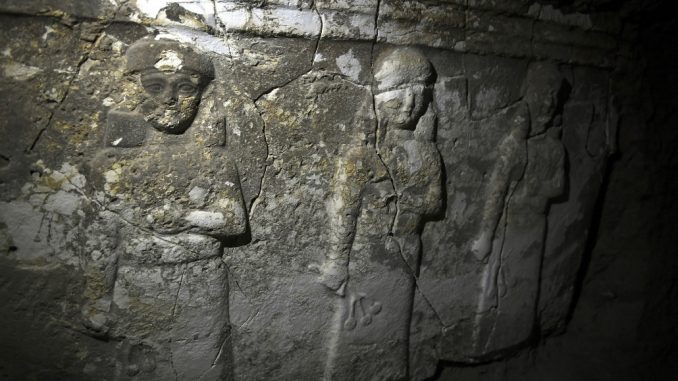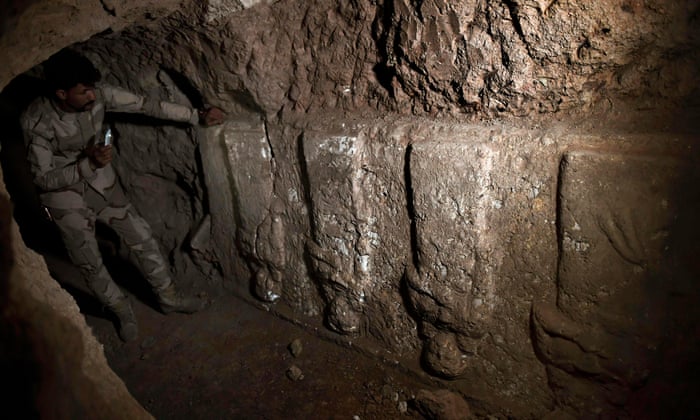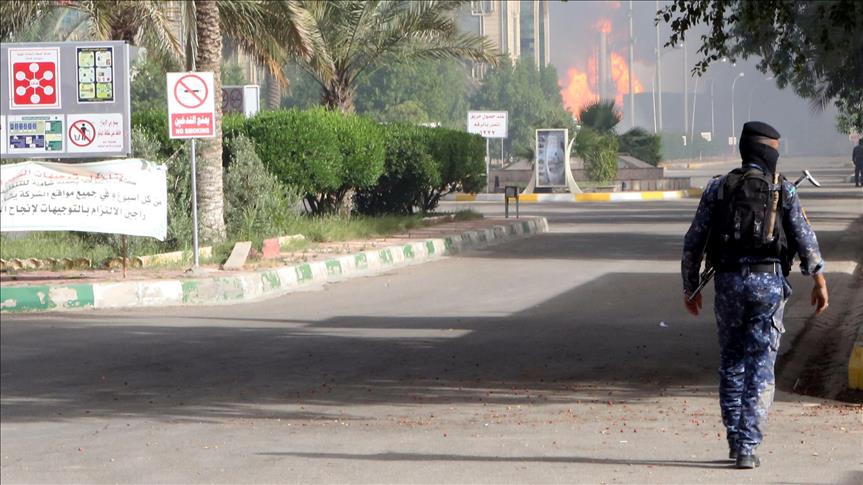
An ancient Assyrian palace was recently discovered by archaeologists in eastern Mosul after ISIS has withdrawn from the area, to open the door to new questions about the group’s finance tunnel from selling artifacts and the huge toll of destroyed history it left behind.
At the height of its power two years ago, Islamic State ruled over millions of people in territory running from northern Syria through towns and villages along the Tigris and Euphrates river valleys to the outskirts of Baghdad in Iraq.
The group launched numerous videos online for its members destroying archeological sites and smashing artifacts that date to thousands of years in both Iraq and Syria. However, many evidence suggests that these were only propaganda to hide the group’s real goal in stealing these artifacts and selling them.
The United States is providing air and ground support to Iraqi and Kurdish forces trying to dislodge the hardline group from Mosul.
Iraqi forces captured the eastern side of Mosul in January after 100 days of fighting and launched their attack on the districts that lie west of the Tigris river on Feb. 19.
The group’s withdrawal revealed extreme destruction that was left behind, yet some new archeological sites which were revealed due to ISIS’ activities.
The newly discovered palace
The Assyrian palace, which apparently dates back to 600 B.C., was discovered by local archaeologists in eastern Mosul underneath the ruins of what used to be the Mosque of Prophet Jonah which was destroyed by ISIS in 2014.
After exploring the tunnels dug underneath the retrieved areas of the city, archaeologists have discovered Assyrian stone sculptures and cuneiform inscriptions which apparently date to back to 7th century B.C.
Archaeologists in the west are avid for more news and better quality photographs of the carved stone reliefs, which appear to represent priests and religious ceremonies. The tunnels were dug under a high mound damaged in 2014 when ISIS blew up a beautiful 12th-century mosque, believed to hold the tomb of the prophet Jonah.
The discovery of a previously unknown temple and possible palace entrance, dating back to the Assyrian period and probably carved in the 5th or 6th century BC, is a rare piece of good news in the context of so much deliberate destruction and looting by ISIS of pre-Islamic archaeology.
British Museum experts in touch with their colleagues in Iraq led by Saleh Noman – who was in the first group of Iraqi archaeologists trained in London to survey and rescue whatever has survived – believe that the ISIS tunnels ran so deep under the centuries of mudbrick making up the ancient mound of Nabi Yunus, that they hit a temple carved into the bedrock.
“So far we have only seen poor quality photographs – but they are extremely exciting,” said Sebastien Rey, lead archaeologist at the Iraq Emergency Heritage Management Programme at the British Museum. “I met Saleh at the Unesco conference in Paris 10 days ago, and was able to discuss it with him and look at his photographs, and there is no doubt that they have found something of great significance.
“The reliefs are unique, they have features which we have not seen anywhere else – they are not at all like the well-known Assyrian hunting and banqueting scenes such as we have in the museum.
“We also have reports – but as yet no photographs – that they have found two lamassu, the famous winged bull figures, which would suggest that they may have been flanking the entrance to a palace, with some form of temple as an annex.
“The archaeologists are incredibly brave. They are working in extreme danger, with the mudbrick in danger of collapse at any time. When it is safe to mount a full rescue excavation this will be a major operation, needing a great deal of resources which will certainly mean international support.”

Revealing new pages of history
Rey is particularly excited by his colleague’s reports of inscriptions in the stone: the Assyrian rulers, very usefully to archaeologists, were fond of elaborate and boastful inscriptions that included their names, dates and achievements.
It was known that there were layers of earlier history under the Nabi Yunus mosque, but it had never been fully excavated.
If the tentative dating of the carvings proves correct, they date from the final period of the once vast Assyrian empire, splintering under external attack and internal power struggles after centuries in which it dominated Mesopotamia and the great city of Nineveh was the largest in the world.
Magnificent carved panels and the gigantic winged bulls, from the palaces and temples of the emperor Sennacherib, are in museums across the world, including the British Museum.
According to AFP, Layla Salih, head of the antiquities service for the region, reported that more than 100 pieces of pottery in good condition, believed looted from the tunnels by ISIS, have been recovered from a house in Mosul, and many more portable objects are assumed to have been taken.
The Unesco conference in Paris in February was told by the deputy Iraqi culture minister, Qais Rashid, that in the Mosul region alone at least 66 archaeological sites had been destroyed by ISIS, some of them converted into car parks. He said that Muslim and Christian places of worship had suffered “massive destruction”, and thousands of manuscripts had been looted.


ISIS’ antique trade, or blood antiques
Analysis suggests the ISIS gets its funding from sources such as donations, smuggled oil (up to $1.645m a day), kidnapping (at least $20m last year), people trafficking, extortion, robbery and last – but not least – the sale of antiquities.
It’s a lucrative source of income – for example, the sale of looted items from al-Nabuk, west of Damascus, is reported to have earned ISIS $36m.
ISIS operates in the richest archaeological arena in the world, the cradle of civilization. While ancient sites at Nimrud, Nineveh, and Hatra are being destroyed, a stream of artifacts suspected to come from such places has appeared on the black market. ISIS either uses so-called ‘bulldozer archaeology’ (unearthing sites using any equipment available which is extraordinarily destructive) or employs locals to dig up sites and tombs. The group then takes a tax, approved by Sharia law, based on the value of any treasure taken. No-one knows what has come out of the ground and such loot is impossible to identify later.
Do not be fooled by the video of ISIS in Mosul Museum smashing ancient Assyrian statues which it claimed were “worthless idols”. ISIS may have defaced important monuments, which it cannot sell, but evidence suggests it is trading in moveable objects, which it can. In any case, the statues in the museum were plaster copies. “None of the artifacts is an original,” says the head of Iraq’s national antiquities department Fawzye al-Mahdi.
“They were copies of the originals in Baghdad Museum made when Iraq was building regional museums”, says Dr. Mark Altaweel, of the Institute of Archaeology at University College London. But large-scale looting has been taking place in Mosul for at least 25 years, with Western demand very high, he adds.
Arthur Brand, of Amsterdam-based Artiaz, one of a growing number of firms which tries to locate stolen art, has dubbed the illicit trade “blood antiques”. While antiques are usually less transportable than blood diamonds, they are potentially far more valuable.
There are numerous reports of antiques from Syria and Iraq circulating in the European black market. Reportedly, Scotland Yard has four investigations in progress related to Syrian antiques – but without much greater financial help, closing down the networks that move the loot around the world seems an impossible task.
“The looters tap into well-established old networks using smuggling routes that often go through Turkey and Lebanon,” says Dr. Altaweel.
Among items in demand are ancient cuneiform tablets, cylinder seals, jars, coins, glass and particularly mosaics, which can be easily broken up and transported. The smaller and easier to conceal and transport an object is, the more valuable it could be.
Christopher Marinello, a spokesman for London-based Art Recovery Group, which advises buyers on due diligence, says there has been intense speculation about the value of looted art. “There are a lot of figures floating around”, he says. “Theoretically, tainted objects are worth a fraction of their true value but it all depends on practicality. A large object that is not legitimate may be worth only 10-15% of its true value in the black market but smaller, more easily transported pieces can be worth a much greater percentage.”




